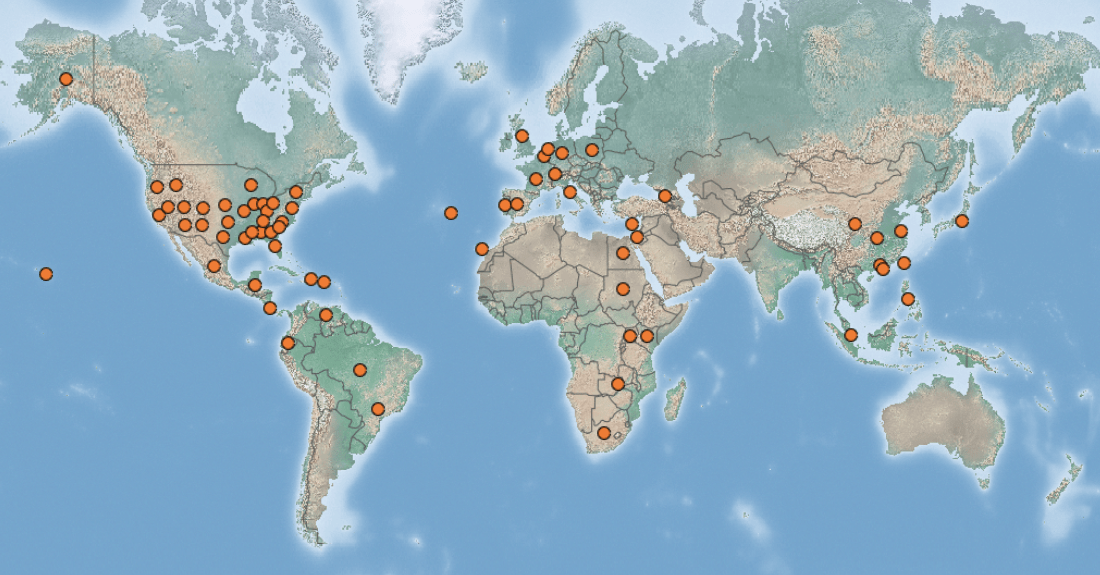 |
Red swamp crayfish | Status LU: absent. |
 |
Roude Suppekriibs | Status Eur.: established. IAS of EU concern (2016). |
 |
Écrevisse de Louisiane | RA: ISEIA: A0, Alert List. |
 |
Roter Amerikanischer Sumpfkrebs | Wikipedia:  | Wikispecies: | Wikispecies:  | CABI | CABI |
 |
Rode rivierkreeft | Back to the list of invertebrates |
Contents
Report the species
→ Report Procambarus clarkii to the National Museum of Natural History.
Brief description
Procambarus clarkii (Girard, 1852) is a species of cambarid freshwater crayfish, native to northern Mexico, and southern and southeastern United States, but also introduced elsewhere, where it is often an invasive pest. P. clarkii is typically dark red, with long claws and head, small or no spines on the sides of its carapace just below the head, and rows of bright red bumps on the front and side of the first leg (Wikipedia contributors 2020).
The red swamp crayfish is most commonly found in warm fresh water, such as slowly flowing rivers, marshes, reservoirs, irrigation systems and rice paddies. It is considered to be the most ecologically plastic species in the order Decapoda, and is able to grow quickly even in only seasonally present water, being able to tolerate dry spells of up to four months. The red swamp crayfish grows quickly, and is capable of reaching weights in excess of 50 g, and sizes of 5.5–12 cm long. It is also able to tolerate slightly saline water, which is unusual for a crayfish. Additionally, P. clarkii are physiologically capable of tolerating relatively low dissolved oxygen concentrations. The average lifetime of Procambarus clarkii is five years (Wikipedia contributors 2020).
The burrowing activities of the red swamp crayfish can lead to damage to water courses and to crops, particularly rice, and its feeding can disrupt native ecosystems. It may out-compete the native crayfish species, and is a vector for the crayfish plague fungus Aphanomyces astaci, for crayfish virus vibriosis, and a number of worms parasitic on vertebrates. Their burrowing activities may also be a threat to civil infrastructure such as storm ponds and levees (Wikipedia contributors 2020).
Status and distribution in Luxembourg
There is no documented occurrence of Procambarus clarkii (Girard, 1852) in Luxembourg yet (MNHNL, iNaturalist & GBIF 2020).
Risk assessment
ISEIA protocol
A0 (3+3+3+3) = Alert List (Ries et al. 2017: 68).
Harmonia+ protocol
Not assessed yet.
Worldwide distribution
Bibliography
- CABI, 2019. Procambarus clarkii. In: Invasive Species Compendium. Wallingford, UK: CAB International. URL: www.cabi.org/isc [accessed 2020-03-13]
- MNHNL, iNaturalist & GBIF, 2020. Procambarus clarkii in MNHNL-mdata, online portal combining species observation from Recorder-Lux, iNaturalist and GBIF. National Museum of Natural History, Luxembourg. URL: https://mdata.mnhn.lu [accessed 2020-03-13]
- Ries, C., A. Arendt, C. Braunert, S. Christian, A. Dohet, A. Frantz, G. Geimer, M. Hellers, J. A. Massard, X. Mestdagh, R. Proess, N. Schneider & M. Pfeiffenschneider, 2017. Environmental impact assessment and black, watch and alert list classification after the ISEIA Protocol of invertebrates in Luxembourg. Bull. Soc. Nat. luxemb. 119: 63-70. [PDF 360 KB]
- Wikipedia contributors, 2020. Procambarus clarkii, Wikipedia, The Free Encyclopedia, 3 February 2020, 18:43 UTC, <https://en.wikipedia.org/w/index.php?title=Procambarus_clarkii&oldid=939000553> [accessed 2020-03-13]
Suggested citation of this webpage
Ries, C. & M. Pfeiffenschneider (Eds.), 2024. Procambarus clarkii (Girard, 1852). In: neobiota.lu - Invasive Alien Species in Luxembourg. National Museum of Natural History, Luxembourg. URL: https://neobiota.lu/procambarus-clarkii/ [Accessed 2024-10-22].
Page content last updated on 2021-05-14.


